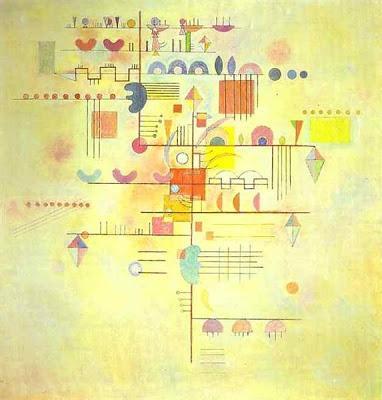
Gentle Accent by Wassily Kandinsky
Whether we need support over the holidays, post election, or just plain in general, learning how to titrate is one of the most powerful and skillful ways to self regulate, re-find balance, and stay in the present moment when we’re working with strong states of mind, heart, and body. Titrating is a somatic approach to managing stressful or painful situations, feelings, thoughts, and memories. When we titrate, we are moving both towards and away from something, so that our nervous system, heart/mind, and body can process what is occurring and not become overwhelmed.When we are “working with what is,” we are feeling our feelings, noticing our thoughts, hearing sounds, feeling sensations—whatever is arising in the present moment—hopefully with kindness and not taking everything so personally. If this seems challenging, you are right, it often is, which is why we practice to cultivate this capacity. It’s also why in the meantime we need to arm ourselves with supportive skillful means, one of which is developing the ability to titrate. By learning skillful, practical, and sane approaches to working with where we are in the moment, we self regulate, stay healthier, are more able to rediscover balance and negotiate our current challenges.
There’s an unfortunate myth going around in some spiritual and mindfulness circles that we must sit with our pain, face it, stay with it, not run or hide from it ever, and there is a modicum of truth to this sentiment. However, in times of deeper trouble or acute discomfort, walking straight into a fire isn’t always the best solution, and can cause the opposite reaction to what we might be seeking which is to shut down promptly rather than open up.
Yes, we want to feel our feelings, whatever they are, but staring them down isn’t always beneficial, especially when a traumatic memory, painful truth, or stressful trigger threatens to pull us into a vortex of deep discomfort. And action or reaction from strong emotion or discursive thinking or triggers isn’t always the best solution and can eventually cause great internal and external harm. We can, however, work with what we are experiencing in smaller doses, so that we can manage situations, emotions, and stronger states of mind without getting lost in the downward spiral of despair, anxiety, depression, or general angst.
So rather than read all the newspapers we used to read or feeling that we have to just swallow something someone that is saying to us that is mean or belittling for instance, we need to be able to step in and out of what we are feeling and experiencing to avoid being overwhelmed. By coming back into the present—taking a pause—we can re-collect ourselves and know the best direction forward or away. We can take skillful and compassionate action where needed—action that comes from the clarity of being in the present moment and seeing what needs to be done or what needs to be left alone.
Sometimes the most available way to practice moving into and away from is by noticing and feeling what is happening internally—touching into feelings briefly (not denying them)—and then literally turning the steering wheel of your mind towards what is in the room, noticing the colors, shapes, objects, the light.
Another way to gently, but firmly bring yourself back to the present and connect with the earth is to practice postures that open the hips. My favorite is Bound Angle pose (Baddha Konasana). Practice it either seated with your back against a wall or supine on a bolster (Supta Baddha Konasana) for up to 20 minutes. You can use either pose for meditation just by making that your intention and paying attention.
While in the pose, allow your mind to fully follow sensations. You’ll notice that the ones that pull you first might be the unpleasant ones. If so, turn your awareness towards the pleasant sensations and even the ones that are neutral in tone and feeling. Feel the pleasant and neutral sensations, wherever they are arising, and pay particular attention to them as they end. All sensations will have a beginning and an end. By paying close attention to sensations arising and passing away, your mind will concentrate on them—you’ll be right where you are, and right with what you are feeling.
Essentially anything self compassionate that allows us to return to something in the present moment is helpful. Going on retreat, or taking a workshop or class are additional supportive tools as they bring us together with like-hearted people for important conversations. They open the doors to deeper and more sustainable practice, and give us a break from being online or at work—both of which we all need dearly.
If you’d like to learn more about self compassion, consider joining me for a mini retreat Self Compassion: The Ultimate Radical Pursuit on Saturday, December 10, 2016, 10:00 am – 3:00 pm, at the Integral Yoga Institute in San Francisco, California.
May these times that call for as many of us as possible to be awake, kind, thoughtful, and prescient be our opportunities to move forward towards alleviating stress, suffering, harmful behaviors, and ways—together.
In kindness,
Jill
Subscribe to Yoga for Healthy Aging by Email ° Follow Yoga for Healthy Aging on Facebook ° Join this site with Google Friend Connect

